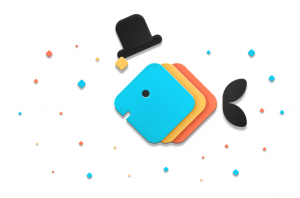
Users of the Studio Polaków mobile app can take part in live studio discussions on their choice of topic.
Social media has profoundly changed the ways users consume and interact with media. Younger people expect the media they use to be on-demand and algorithmically curated or personalised. To meet the requirements of such users and ensure their engagement, publishers need to find ways to enhance user experience (UX). How are Polish media outlets responding to this challenge?
Facebook, YouTube and Twitter have become supremely adept at winning users’ engagement because their business models depend on it. The longer they can persuade us to stay on their sites, the more effective and valuable their ads become. For years, creating UX able to attract and retain users’ attention was the Holy Grail, regardless of the quality of the content.
The big tech platforms now face criticism for hooking us in with the kind of tactics previously associated with the world of gambling, but it is no longer possible to force the genie back into the bottle. Today’s users expect all content to be engaging, easily digestible, personalised and delivered in real-time. The media’s job is to meet those demands without sacrificing too much in terms of quality content.
Young people depend heavily on mobile and spend a lot of time on social networks. According to the Reuters Institute Digital News Report 2019, an ever decreasing number of users are now accessing websites or news apps directly. More and more people are accessing news via social media, despite the fact that trust in news accessed in this way remains low.
Polish publishers are working hard to reverse this tendency and forge direct bonds with their audiences. Their efforts are currently focused on improving the UX of their products, with the aim of making them mobile-friendly and personalised. But they also want their products to be seen as reliable sources of information.
Meaningful content
Polish news publishers have been eagerly embracing new technologies, and several of them have been experimenting with the creation of mobile apps as a way of attracting readers. The main target audience for these apps are busy people who want to be informed but who tend to consume their news in short bursts while on the move.
The publisher of Polityka, one of the best selling opinion weeklies in Poland, is seeking to meet this need with the app Fiszki Polityki (Polityka flashcards).

The Fiszki Polityki app presents the news via a series of virtual flashcards.
This app presents articles in a mobile-friendly form: instead of having to scroll through a huge amount of plain text, the user simply flips virtual flashcards bearing clearly presented factual news stories.
“This is an app for those who want to be up-to-date, but don’t have time to read long stories or to follow news sites”, Mariusz Hemra, the coordinator of the app, told EJO. “It allows users to catch up on the whole day in just a few minutes but also to read slightly longer articles, for example while on the tram or standing in a queue,” Hemra added.
The content is delivered in an easy-to-digest format and can be read in bite-sized chunks. According to Hemra, “this addresses the needs of younger readers, who mainly gain their information via smartphones”.
But a user-friendly format is not the only thing that readers look for. Meaningful content is also important to them. Content for the Fiszki Polityki app is curated by an editorial team consisting of named journalists, who fillet the material and present it in flashcard form.
Perhaps surprisingly, take-up of the app has not been limited to one age group. “Our app connects multiple generations of Polityka‘s readers – both those who have known us for years and the newcomers”, Hemra told EJO.
New methods of consumption
A similar aim informs the WP Blast project developed by Wirtualna Polska (WP), the publisher of one of the biggest net-native news websites in Poland.
WP Blast seeks to “change the way young readers consume content” (in the words of the project description). It does this by dividing the traditional message structure into three parts: first, the reader finds out “what happened”, then “what is the result” (of the event), and finally the impact of this – “how it affects his life”.
The content is presented in a way that enables the user to access quickly the parts that interest them. The manner of presentation makes it possible for the user to move freely from one section to another and to select information by swiping and tapping.
WP Blast is aimed at two groups of readers: the Millennials for whom mobile is their device of choice for consuming news (so called “mobile first”) and Generation Z for whom mobile is the only device they use (“mobile only”).
“These are the groups who do not accept traditional forms of narrative, plus news publishers are not their first source of news; they prefer social media and news apps”, Nino Dzikija, head of product innovation at Wirtualna Polska, told EJO.
With these users in mind, Wirtualna Polska plans to make WP Blast a completely new news format. “We will take into account the habits of younger users and make them a new norm of news consumption for everyone. Things that are currently limited to young people, such as multiscreening, will tomorrow be absolutely normal across the board. It’s all about efficiency”, Dzikija declared.
Interaction and personalisation
Fratria, the biggest publisher of right-wing media in Poland, has chosen a slightly different method of tapping into the needs and media consumption habits of Millennials. The publisher – whose stable of titles encompasses the political weekly Sieci, the economics monthly Gazeta Bankowa and the news website wPolityce.pl – decided to focus more on interacting with its audience via its online TV channel WPolsce.pl.
A mobile app called Studio Polaków (Polish studio) allows users to choose the topics that interest them and select the journalist they would like to discuss these issues with. The discussion is then broadcast live on WPolsce.pl.
“Our readers and viewers love to interact with journalists. They send e-mails, make phone calls and leave comments on our social media channels, so we decided to engage them even more”, Michał Jędrzejkowski, digital project manager at Fratria and head of the Studio Polaków project told EJO.
The format enables Fratria to offer an element of personalisation – something else that appeals to Millennials. Digital-savvy young people like the fact that it gives them a chance to take part in a TV show, as this makes the experience more like social media.
“By using the Studio Polaków app, viewers can have discussions on any topic with no restrictions and without having to come into the studio. All they need is internet access and a smartphone”, Jędrzejkowski explained.
So while most Polish news publishers would still insist that quality content is their No.1 priority, the user experience comes a close runner-up.
Main image: Screengrab from online TV channel WPolsce.pl programme Studio Polaków / Second image: Logo of Fiszki Polityki app (Polityka.pl)
If you liked this story, you may also be interested in The State of the Media is Mobile.
Sign up for the EJO’s regular monthly newsletter or follow us on Facebook and Twitter.
Tags: big tech, Fiszki Polityki, Fratria, Generation Z, interaction, millennials, mobile apps, News consumption, Personalisation, Polityka, Studio Polakow, Trust in News, User experience (UX), Wirtualna Polska, WP Blast













































